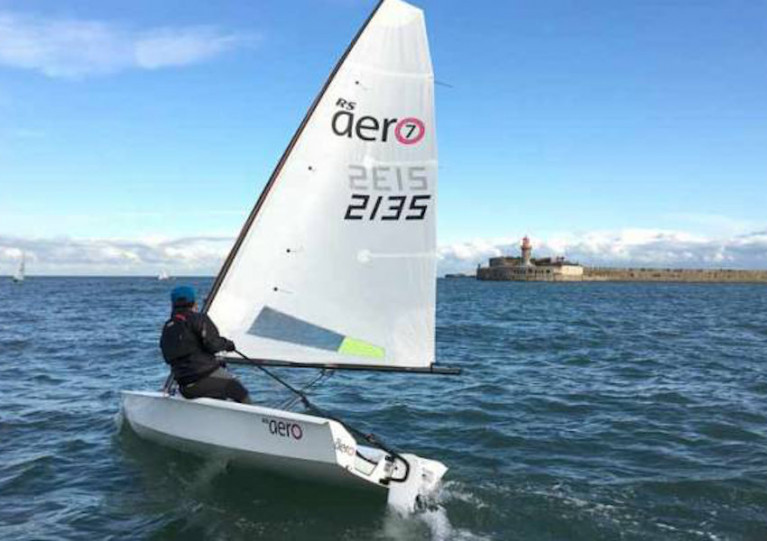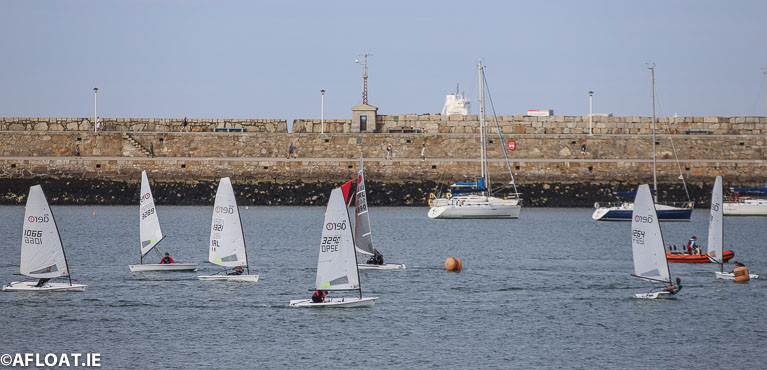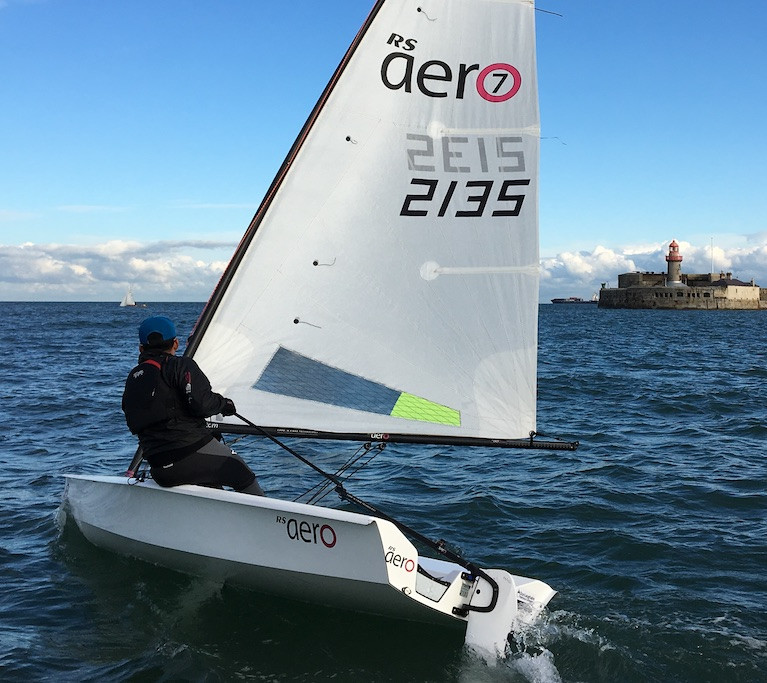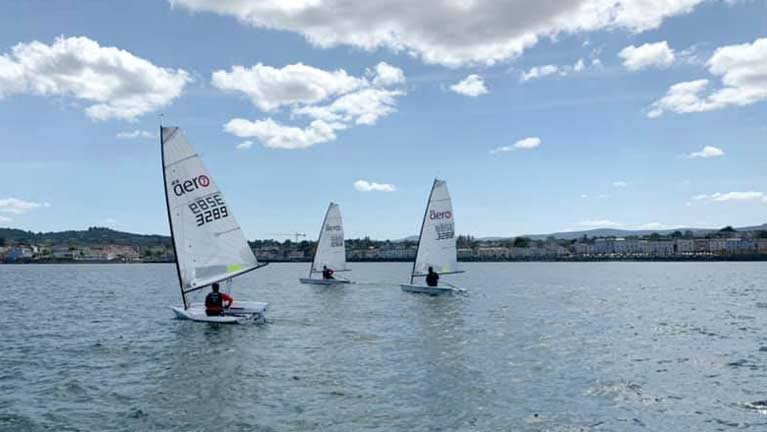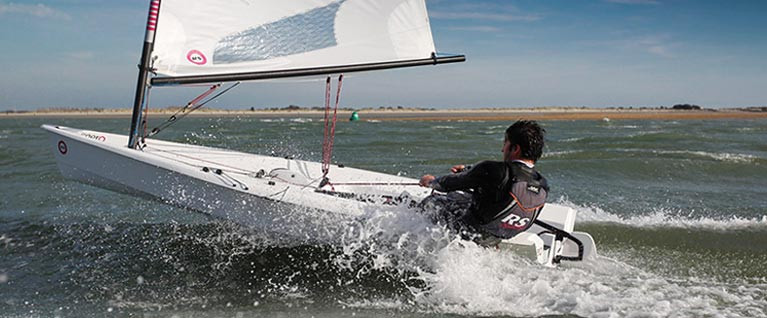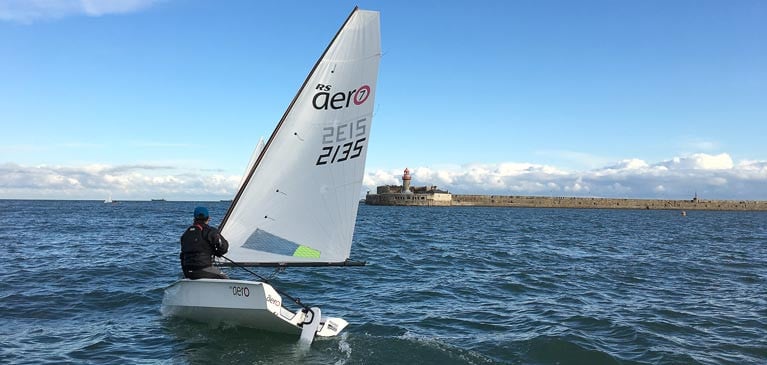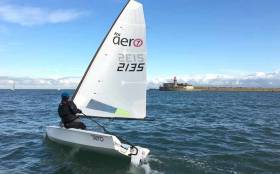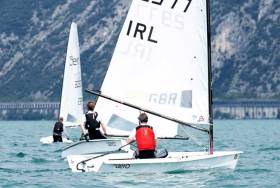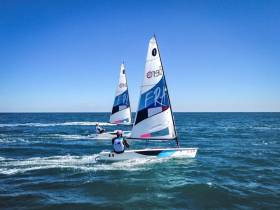Displaying items by tag: rs aero
It will come as no surprise to RS Aero owners that dinghy historian David 'Dougal' Henshaw, picked the RS Aero as the best dinghy to emerge in the last 10 years writes Irish RS Aero Class Chairman Brendan Foley.
Commenting at the recently run RYA Dinghy Show, Dave said "The dinghy of the decade can only be the RS Aero. Look at pictures of the RS Aero sailing in breeze, that lightweight hull, the magic of a Jo Richard's design and you think...WOW! (Simple, identical).....offers competition, speed and thrills. Far more than just a modern Laser - a classic boat and a class act in its own right!"
The RS Aero in great company with David selecting some other excellent boats in the mix.
- 1950's - The 505
- 1960's - The Fireball
- 1970's - The Laser
- 1980's - The B14
- 1990's - The RS 400
- 2000's - The Bladerider Moth
- 2010's - The RS Aero
See the fascinating full talk here (31.20 for Aero segment)
New RS Aero Irish Fixtures for 2021
In other Aero news, there are new dates planned for 2021.
- 1st May, Spring Chicken, Ballyholme Yacht Club, Bangor. (5/7/9)
- 19th / 20th June, Aero Open / Irish Nationals, INSS, Dun Laoghaire, Co Dublin. (5/7/9)
- 2nd - 4th July, Volvo Dun Laoghaire Regatta, Combined Clubs, Co Dublin. (7)
- 14th /15th August, Northern Championships, Carrickfergus Sailing Club. (5/7/9)
- TBC September, Eastern Championships, East Coast Club. (5/7/9)
All dates are contingent on IS/RYA C-19 guidelines.
Building RS Aero momentum
For the 2022 season as the numbers build, the RS Aero plan to have a Western and Southern championship. Kenny Rumball, RS Dealer for the Republic of Ireland, says that three new boats have come in and are sold with another batch on order.
There is also good news for lighter men and many women as well as those who previously sailed Laser Radials.
A 6 rig more similar to a Radial to fit between the 5 and 7 rigs is at an advanced stage of discussion with RS and National class associations.
When possible the class plans to have a number of open days for people to try out the RS Aero, details of which will be published on Afloat
We hope to see you all back on the water this Summer and look forward to fun, friendship and great racing.
The National Yacht Club has cancelled its previously scheduled January training sessions in the RS Aero due to the extended Level 5 coronavirus restrictions.
It's hoped the sessions will be rescheduled for future weeks as restrictions allow. The NYC website will have an update on details accordingly.
While this training cannot go ahead as planned, it nevertheless marks a recognition of the growth of the RS Aero class which now has 25 boats across Ireland, as recently reported on Afloat.ie.
New RS Aero Class Reports Growth with 25 Boats Now Across Ireland
Brendan Foley, Chairperson of the Irish Aero class outlines developments in the new lightweight single-hander from RS
If you were to pick a year to get a class going, 2020 would not be the year that you would pick, where Covid-19 has impacted sailing in a stop-start way. The RS Aero class, however, has bucked the trend and grown in numbers and reach, around the island of Ireland.
Growth in RS Aero numbers
Current numbers stand at 25 in Ireland. Dublin is the main centre with 14 boats based out of Dun Laoghaire, Swords and Howth. Add in Greystones and that number rises to 16. A fleet is based on the east coast of Northern Ireland with the majority based at Ballyholme Yacht Club.
There is one Aero in Cork Harbour and the expectation is that a contingent of Munster dinghy sailors will be attracted to this spritely class.
We are delighted with the growth in the class and there is very strong interest in new boats for 2021. Clearly, when people can travel to mainland UK, they will be able to access second-hand boats at very competitive prices. The main RS dealers in the North and South also have some very good packages available on new boats.
Some of the sailing diehards forced out of keelboats and double handers by Covid, turned to the RS Aero rig and hull as the obvious choice for fun, versatility and ease to get on the water. We were all encouraged by the sailors entering the class and knew we would have competitive racing. Training and coaching have been strong from the outset, with plenty of opportunities to build skills, when racing was denied. Indeed most of us get out several times a week, whatever the weather, where restrictions and facilities allow.
Of interest when new boat owners were asked why they bought the RS Aero over other single handers, the reasons are quite varied.
Here are some the comments from owners;
- Faster and more fun than a Laser
- Really light pulling up and down slipways
- Fast to rig so can get in and out for a sail in short window
- I thought they were going to be the Olympic single hander so wanted to get one
- Getting out of big boats and wanted something fast but also easy
- I hate gyms, wanted to get fit and this looked like fun
- The International events circuit is really, really good
- Even if you are not winning you are having fun
The people buying RS Aeros range from multiple national champions to people getting back into dinghies to single-handed sailors looking for something different. There is a strong female contingent in the fleet and the age ranges go from 14 to older than people are prepared to say (definitely well into his 60s)! While competitive, the class is renowned for its welcoming and friendly approach. Race winners share what they did to win races so that everyone learns and grows. Class members even make equipment for each other (Thanks Stephen Oram for the digitally printed compass mounts). The class is inclusive rather than exclusive and fun is high on the agenda!
RS Aero Racing
The racing results from PY sailing this year demonstrate the potential of the RS Aero under handicap with Noel Butler winning the DBSC PY Tuesday Series and the author taking the DBSC PY Saturday Trophy. With numbers growing so strongly in Dun Laoghaire the RS Aero has already overtaken some established dinghy classes who have their own starts in DBSC racing, so it’s likely for the 2021 season the class will have their own start.
Like so many classes the RS Aero had to abandon the running of the Irish Open due to C19 restrictions. This makes 2021 even more important as the inaugural RS Aero Irish Open will now run with even more boat. (Make sure to keep an eye on afloat.ie – where dates for the Irish Open will shortly be published).
Daragh Sheridan of HYC braved the C19 restrictions and quarantine to race the UK Nationals in August (the only overseas competitor). Sailed in a windy Eastbourne he finished a brilliant 12th place in the 7 fleet, the biggest fleet of the championship with 57 competitors.
As racing was cut short in October with lockdown Aeros all over Ireland have been posting great footage to the class Facebook page, of burns in the excellent sailing conditions over the last few months.
 Daragh Sheridan of HYC competing at the 2020 British National Championships in Eastbourne
Daragh Sheridan of HYC competing at the 2020 British National Championships in Eastbourne
The future of the RS Aero
2021 will also likely see the addition of a new 6m² rig to the fleet. Currently, the RS Aero has a 5, 7 and 9 square metre sail. Many feel the 5 can be underpowered in light airs, and the 7 overpowered in over 18/20 knots, so the sweet spot of a 6m² rig is currently being trialled at UK events this winter, with positive feedback. Many of the Irish fleet have signalled their intention to get a 6 rig which will see a wide range of female, youth and male competitors able to compete together.
 The RS Aero 6 sail
The RS Aero 6 sail
Given the level of interest wherever an Aero is rigged, we expect continued growth from other youth and adult single-hander classes. The fleet will continue to race with all rigs on a PY basis until such time that the introduction of 6m² rig and/or critical mass allows a split.
Race Calendar (provisional and subject to COVID)
- A large contingent of RS Aeros will race in the DMYC Frostbite and Ballyholme Winter Series over 20/21 when C19 rules permit.
- The RS Aero Fleet will compete alongside the other RS classes on the RS circuit for 2021 – dates have been announced and intention is where possible to for the Aeros to race with the other RS fleets.
- Easterns - Greystones Sailing Club - Dublin - April - 24/25
- Southerns - Baltimore Sailing Club - Cork- May 29/30
- Leinsters - Dun Laoghaire Regatta Week - Dublin - July 2/3/4 - 200/400 Only
- RS Eurocup - Garda - July 26-30
- Inlands - Blessington Sailing Club - Wicklow - July 24/25
- Northerns - Carrickfergus Sailing Club - Antrim - August 14/15
- Nationals - Rush - Dublin - September 10-12
Ballyholme Yacht Club will hold an Open regatta for RS Aeros on the 1st and 2nd of May 2021. For the adventurous, the worlds will be held in Lake Garda, Italy in 2021.
As C19 restrictions ease, the class and RS dealers in Dublin and Belfast will be putting on demo days to try out the amazing RS Aero. Dates will be posted on afloat.ie shortly. Chat to your local Aero owner and they will be happy to give you a spin so you can check out the boat.
RS has also just released a new rigging video which gives a good overview of the boat;
RS Aero Irish Open Postponed at Dun Laoghaire Harbour
The Irish National Sailing & Powerboat School together with the Irish RS Aero Class Association have decided to postpone the inaugural RS Aero Irish Open, due to take place in one months' time on Saturday 19th and Sunday 20th September.
Following the latest public health advice, the postponement will allow for greater certainty of the event proceeding. While the 19th and 20th of September are after the new restrictions are due to be lifted, the decision means competitors and officials will not have to make commitments with the uncertainty as to possible restriction extensions.
The Irish National Sailing & Powerboat School is looking forward to welcoming the Irish Aero Class now on Saturday 24th and Sunday 25th October.
Event details will be updated on the RS Aero class website in due course.
Irish RS Dealer and INSS centre principal Kenneth Rumball says "The primary motivation for the Irish RS Aero Class and the Irish National Sailing & Powerboat School is everyone's safety and wellbeing. This postponement provides the best possible chance for the event to proceed safely and takes the pressure off competitors and officials in an uncertain environment".
Separately, a shipment of new RS Aeros are due to arrive in Ireland in early September, and it is hoped that new sailors can be welcomed to the class in advance of the event. Demo sails are available at the Irish National Sailing & Powerboat School if any prospective Aero owner wants to give one a try.
Fireball Aces Join RS Aero Dinghy Fleet
The Irish RS Aero dinghy fleet grew by six over the last week and a half. The class now stands at over 20 boats and the Irish National Marine Services team handed over one of the demo boats for a trial only this morning.
“We are delighted to welcome the latest Aero sailors to the Irish Fleet. With 6 new boats launched this week and more on the way the class is set for great growth in 2020 - our new owners bring a great mix of fun, enthusiasm and great racing skills", says Brendan Foley Chairman RS Aero Ireland Association.
Recent additions to the class include Karl Leavy of Swords Sailing Club, who took possession of his new boat just in time for the lockdown to hit!
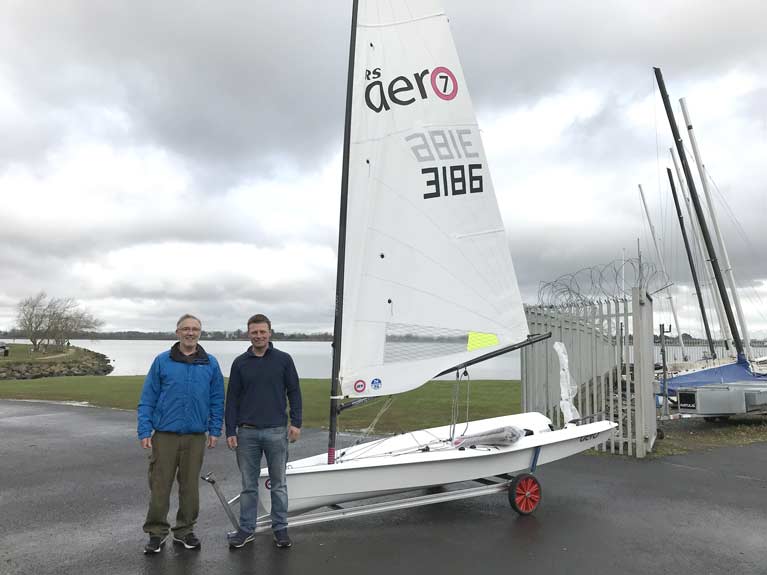 Karl (left) receives his new RS Aero from RS Sailing dealer Kenneth Rumball
Karl (left) receives his new RS Aero from RS Sailing dealer Kenneth Rumball
Only last week Rob Hastings of Bosun Bob’s delivered a new boat to Andrew Baker, while Irish National Marine Services supplied Fireball Aces Noel Butler and Stephen Oram a new boat apiece while Philip Trickett and Charlotte O’Kelly show how the various rig options can allow the whole family get use of the same boat! And it was only on Sunday when Daragh Sherridan took possession of his new Aero.
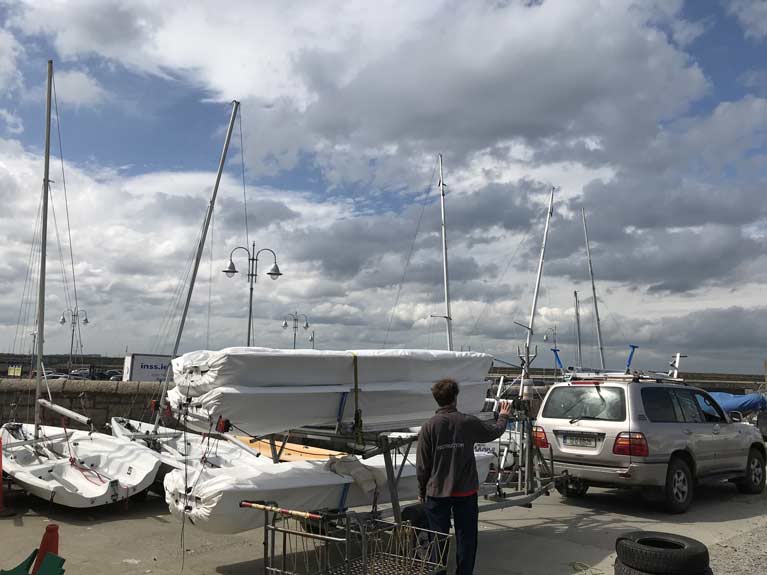 Three new Aero dinghies arrive in Dun Laoghaire Harbour
Three new Aero dinghies arrive in Dun Laoghaire Harbour
Currently, a large portion of the Dun Laoghaire fleet is based at the Irish National Sailing & Powerboat School while the sailing clubs are moving the cruisers off the decks. Indeed many of Dun Laoghaire’s dinghy sailors can call the coal harbour slipway home for a week or two, with regular sightings of sailors based on the Eastern side getting a taste of the marina fairway and “Hell’s Gates”. Glyn Williams of the Irish National Sailing & Powerboat School has been on hand as a safety boat operator for the Aero class and reports “Everyone is taking the new social distancing measures in their stride which is certainly encouraging for more activity afloat”.
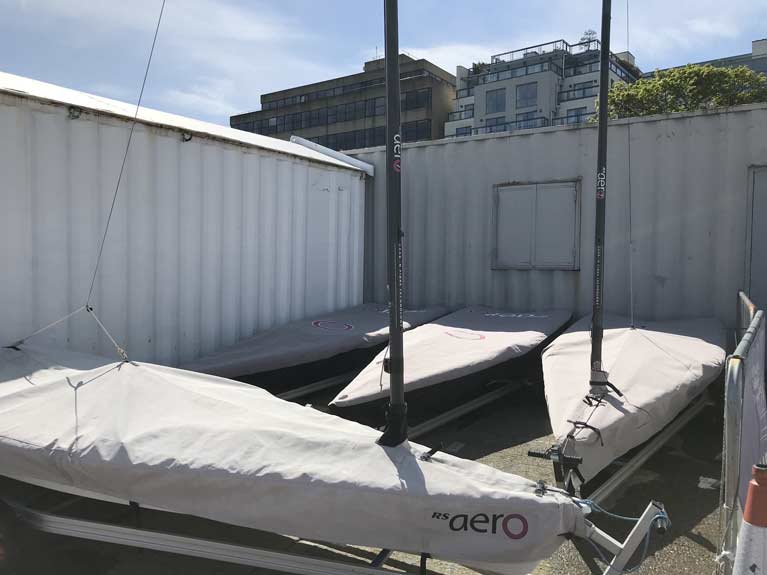 The temporary RS Aero Dun Laoghaire base nestled into the INSS patch in the Coal Harbour
The temporary RS Aero Dun Laoghaire base nestled into the INSS patch in the Coal Harbour
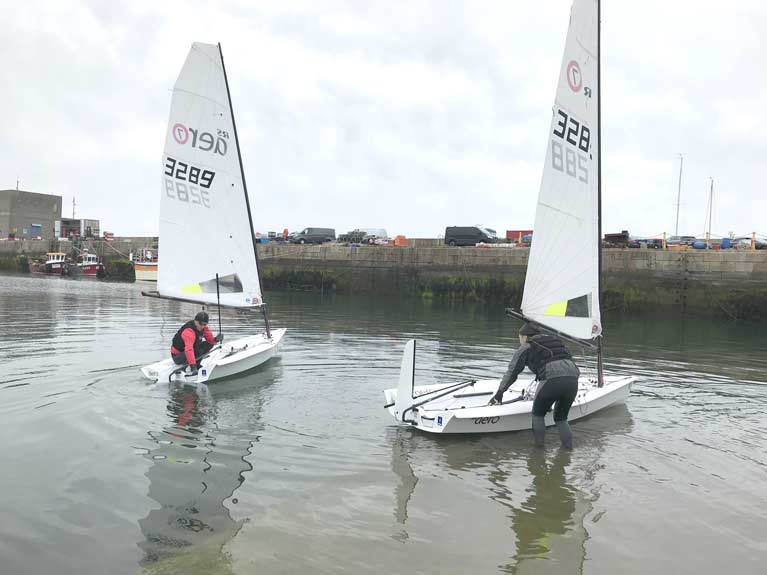 Fireball champions Noel Butler and Stephen Oram get afloat for the first time
Fireball champions Noel Butler and Stephen Oram get afloat for the first time
It’s now full steam ahead for the RS Aero Irish Open rescheduled to Saturday 19th and Sunday 20th September. While there has been some speculation as to why the date was chosen given the Laser Masters will be running the same weekend, the explanation is really rather mundane, it was when the RS Aero charter fleet was available. Enquires for charter Aeros can be sent to Kenny Rumball, [email protected], or to [email protected].
The gang all headed out on Sunday afternoon, making the most of the weekend’s excellent weather, with class chairman Brendan Foley providing RIB support as they got to grips with the new boats in Scotsman’s Bay. Some footage of the occasion was captured!
RS Aeros set sail on Dublin Bay - Video
Two solo dinghy events look set to clash at Dun Laoghaire Harbour in a revised Irish sailing fixture list that is taking shape as the sport plots a return to sailing after COVID-19.
The RS Aero Open Championships that has been rescheduled for September 19/20 will clash dates with the Irish Laser Master National Championships also rescheduled for that weekend at the same venue.
There is no problem accomodating both fleets on any one of Dublin Bay's many race tracks but given the solo nature of both dinghy types there will, unfortunately, be overlap between competitors hoping to compete in both events, especially those sailors keen to try out the new RS Aero design on offer from the Irish National Sailing School.
RS Aero Chairman Brendan Foley adds:
I'm dropping you a note to update on the inaugural RS Aero Irish Open which clashes with the Laser Masters event in September. In my capacity as RS Aero Ireland Class Chairman, we would be absolutely delighted for sailors from other fleets to try out the RS Aero, so it's a pity about the date clash in September with the Lasers. The reason for running at that date is that it's the only window we have to get the UK charter fleet over.
For anyone who would like to experience the Aero on another date - Kenneth Rumball at the INSS or Rob Hasting at Bosun Bobs will be happy to arrange it. Private owners are also pretty good about giving people a go in their boats. It's a very friendly and open class and we welcome anyone who has an interest in learning more. I'm at the Royal St George Yacht Club, Mark Gavin is at the National Yacht Club, Paul McMahon is at Howth Yacht Club and Robin Gray is at Ballyholme Yacht Club.
All are happy to share their experiences of the amazing Aero. We are keeping our fingers crossed for good weather on September 19th/20th and hoping that the Covid-19 situation will have improved by then, allowing us to have a great inaugural RS Aero Irish Open. Until then - stay safe, stay calm, stay positive.
“Today we should be reporting on a fantastic first event for the RS Aero in Ireland. The Irish National Sailing & Powerboat School was due to host the inaugural RS Aero Open last Saturday 2nd and Sunday 3rd of May in Dun Laoghaire Harbour, with a strong fleet of over 20 boats from the UK, roughly 20 Irish boats and roughly 10 RS Aeros available for charter between RS Sailing and the Irish Supplier Irish National Marine Services”, laments Glyn Williams of the Irish National Sailing & Powerboat School.
The RS Aero calendar has, like everything, had to adapt to the coronavirus situation. The class has elected for a new date on Saturday 19th and Sunday 20th September, to fit into the currently remaining dates in the RS calendar, and the pressures on the RS Sailing Aero Charter Fleet, which is in hot demand across Europe later this year.
"sailing’s best bet for dealing with coronavirus is to get back to basics"
Irish RS Aero Class Chairman Brendan Foley is optimistic. “As we all look forward to emerging from our isolation from each other and the water, I am really excited by the number of questions I’ve been getting about the Aero. With a massive focus on single-handers, it looks like this year will be a real turning point for the Aero fleet in Ireland - if you are sitting on the fence and thinking about a new boat, go for it. It will be great for your mental health and well-being. I know I’m keen as mustard to get back out in my Aero. I would also ask prospective sailors to join the RS Aero Ireland Facebook group and the global Facebook group to see what a friendly and progressive fleet this is. I’m happy to answer any questions on the Aero - pop them on the comments below or PM me on Facebook. Stay calm, stay positive and get ready to sail!”
Back onshore, RS Sailing dealer, Kenneth Rumball has been preparing the three Aeros in the Irish National Marine Services stock. Kenneth reports a significant upturn in enquires about the boat since the lockdown began, something he attributes to the expected boom in single-handed dinghy sailing. “The Aero is perfect for those who are looking to get back into dinghies, the ergonomic hiking position, higher boom and centre mainsheet make sailing a breeze”. There are even a few lockdown discounts on the stock boats. The latest Aero ready to go 3187, is shown in the video below, and Kenneth points out the features making it an easy dinghy to get back afloat in.
Kenneth and Glyn feel that sailing’s best bet for dealing with coronavirus is to get back to basics. “Get out on the water and enjoy yourself, either in a single-handed dinghy, or with the family,” says Kenneth, while urging caution to do so responsibly. To this end, the Irish National Sailing & Powerboat School is going to make its COVID-19 single-handed dinghy operating procedure available for all to take ideas from. According to Glyn Williams “It's about ensuring that activity happens safely and that no one takes risks resulting in the need for Lifeboat or Coastguard intervention, exposing these volunteers to risk. We’re in the process of examining the risks, what control measures can be taken and how to manage any issues that arise in a manner that does not allow for disease spread”.
Both are hopeful that straightforward, sensible actions can facilitate a return to sailing and getting afloat to enjoy the water while we await a return to what could be considered a more normal set of activities.
Exciting Future for the RS Aero Class in Ireland Predicted
“Momentum behind this innovative and exhilarating dinghy is building in Ireland, and opportunities to engage a wide range of dinghy sailors cannot be overlooked”. Irish RS dealer Kenneth Rumball, is sure in his assessment of what the RS Aero can do for sailing in Ireland.
What makes the Aero such a good fit for the sailor?
The design philosophy for the Aero was to prioritise ultra-light weight, performance and practicality in producing a dinghy for suit sailors between 35 and 100kg. Weighing about the same as an Optimist, and with a variety of rig sizes, you’re sure to have fun afloat, no matter the wind strength. The lightweight design allows for easy transport to and from the water, and even onto the roof of a car, and places the aero as the perfect dinghy for kids, women and men.
The Aero was designed as a hiking boat from the outset. Dun Laoghaire Aero sailors attest to the comfort when sailing – you may not even need hiking pads! This comfort extends to tacks and gybes, with a high boom removing the need to stoop very low when crossing the boat. The Aero has been developed with lessons learnt from previous successful designs, such as improved ergonomics, centre mainsheet system and foils that slot with precision into their cases
Owners will benefit from the unrivalled RS dealer back up and support for spares. Up to 100 shipments leave RS Sailing’s HQ daily, heading all around the world, with excellent freight cost efficiency.
Worldwide numbers of boats are growing rapidly, and event programmes are building quickly, with World Championships being held annually since 2017. While the Aero was not successful at the recent World Sailing Olympic equipment selection process, it did receive the highest score in the One-Person Olympic Equipment Evaluation Report, unanimously considered the best option by the wide range of experts involved. RS Sailing have worked tirelessly to provide an unrivalled international support network for the class, and coupled with the ethos of RS sailing, it would be very foolish to write off the prospects of seeing the Aero one day at the Olympics.
Dynamic three rig system
Key to this broad appeal is the dynamic three rig system. The RS Aero 5, RS Aero 7 and RS Aero 9 rigs cater for a 35-100kg weight range. Using common top sections and booms, but differing bottom sections, these rigs options have been designed with sufficient control to totally flatten and twist the head of the sail upwind reducing the healing moment. This allows a greater sail area to be carried – a big benefit downwind and in lighter conditions. The tracked mast and halyard allow for easy mast stepping, especially in big breeze.
Why the RS Aero is perfect for Dublin Bay
When most of us get to sail there rarely is enough wind to propel foiling boats, and the Aero with is lightweight construction allows for an exhilarating sail in all wind conditions. If foiling takes your fancy, the lightweight full design allows for many non-RS approved, but thoroughly usable, foiling kits available.
With 4 boats now sailing in the DMYC Frostbite Series, the class is growing rapidly. Coupling this with the scheduled RS Aero Irish Open, there never has been a better time to get afloat in an Aero!
The Irish RS Dealer, Irish National Marine Services, is working in conjunction with RS Sailing to offer a special price for the first four additional boats brought into the country. If you’re still not convinced, a demo sail can be organised.
RS Aero Irish Open – 2nd and 3rd May 2020
The RS Aero Irish Open takes place on Saturday 2nd and Sunday 3rd May 2020. The Irish National Sailing & Powerboat School will host the inaugural event from Dun Laoghaire harbour with racing on Dublin Bay.
RS Sailing will support the event with a charter fleet and there is already good interest from RS Aero sailors in both the north and south of the UK. Added to the emerging Irish RS Aero fleet we should be in for a fabulous first event in Ireland!
The early event page is here which shall evolve as more informative and online entry is launched in due course.
Contact:
- Irish National Marine Services: marineservices.ie
- Telephone Kenneth Rumball: 086 407 4275
What are Irish RS Aero owners saying?
Brendan Foley on why he chose the Aero over other options
After racing big boats for 20 years when I wanted to get back into dinghies, I wanted a boat that would be; fun, fast, easy (for a 43 year old!) and challenging enough to push me too. Foiling looked cool but I didn’t fancy flip flopping from wing to wing in light weather. The more traditional single handers of my youth felt a bit dated. The RS Aero was intriguing as you get sailing in all conditions plus the option of foiling. After sailing the boat, I was hooked by the simplicity and the windsurfer like acceleration. The square top main and carbon rig is super responsive, and the lightness of the hull and its shape make hiking bearable! - Brendan
Paul McMahon – RS Aero Owner details what a new sailor can expect from the class
I have been lucky enough to race the RS Aero in four events over the last few years, each time I was able to avail of RS Sailing’s generous charter scheme (their shore side support at the events is also second to none).
My first impressions of the boat were extremely positive. Cockpit layout is well thought out, outhaul and cunningham very close to your forward hand for easy adjustment – and my favourite the water bottle holder at the back!
I remember thinking that it was in effect a modern laser, it’s not! It is a very different boat, one that needs to be sailed to understood. The boat is really rewarding to sail, upwind, it responds well to body movement and sail control. Reaching, it has a bit of get up and go, she planes easily. Downwind, she responds well to changes in angles and gusts – Loads of gains to be made on the runs with good positioning and technique.
After my first sail in the Aero, I was hooked, the purchase decision was made. It took a little longer to persuade my partner – not much to be fair. Racing in the class is very competitive, but there is a good spread of abilities – so wherever you end up in the fleet there will be close racing. The top sailors in the class are extremely generous in sharing their knowledge, so you can quickly get up to speed. This also makes the class a good class for the first steps into dinghy racing.
Peter Barton (probably the fasted Aero sailor about) will often give a detailed introduction to the boat along with go-fast tips – similar to below;
Any of the Aero sailors are happy to help and offer useful bits of advice when needed.
I’m really looking forward to the first real Aero Class racing event in Ireland, without a doubt the boat is going to appeal to dinghy racers in the country. Early interest from the Irish dinghy sailors is strong and it will be a great opportunity to show any travelling U.K boats some Irish hospitality. - Paul
Howth's Paul McMahon Takes Fourth at RS Aero 7 Euros on Lake Garda
Howth Yacht Club's Paul McMahon took fourth overall at last week's RS Aero 7 European Championships on Lake Garda in Italy.
The former number one ranked full rig Irish Laser sailor was in the mix for the final overall podium places that changed several times during the last race providing a cliff hanger finale decided only by a boat length from the finish line with just one point ultimately separating the top three overall.
Results and some class reports and the usual RS vids are here
RS Sailing says it respects the World Sailing council vote to retain the Laser as the Men’s and Women’s One Person Dinghy event for the 2024 Olympic Games in Paris — while also hailing the RS Aero’s superior evaluation.
As reported yesterday on Afloat.ie, sailing’s world governing body voted in a secret ballot on the last day of its Mid-Year Meeting on Sunday 19 May to retain the Laser and Laser Radial.
This was despite the upstart RS Aero outscoring the incumbent — which faces a name change amid a dispute between the class association and its former leading manufacturer — by more than 10% in a detailed evaluation and sea trials conducted this past March.
Reflecting on the decision taken in London on Sunday, RS Sailing said it “would like to sincerely thank World Sailing for giving the RS Aero the opportunity to be part of the 2024 Equipment Selection for the Men’s and Women’s One Person Dinghy.
“We were impressed throughout the whole process by the Evaluation Team, World Sailing staff and the Equipment Committee who did a very professional and impressive job. We were extremely confident in the depth and thoroughness of the Evaluation Panel to conduct a fair and complete evaluation process.
“RS Sailing also sends a heartfelt thank you to all our followers and sailors, old and new, and have been completely overwhelmed by the global support for the RS Aero and RS Sailing. You’ve all genuinely been on this journey with us and it feels like we’ve made a whole load of new friends in the process.”
The UK company said it was “undeniable that the RS Aero has been proven superior in almost every aspect” and cited comments from Dina Kowalyshyn, chair of the World Sailing Equipment Committee, who noted the boat’s light hull and size (which “make it attractive and suitable for the youth pathway”), its “modern materials and modern production methods”, and the fact that it is “mass production ready”.
“We couldn’t be prouder of the RS Aero,” RS Sailing added. “We have known for a long time that it was an awesome boat to sail but it’s now proved itself irrefutably to the world that it is.”
The company said it understands there are issues beyond determining what is the best performing equipment when it comes to the selection process.
“When the world is so heavily invested in legacy equipment it’s hard to move on from it,” it said, adding that it will continue to encourage World Sailing council members and member associations “who are eager for change from heavier, 50-year-old design equipment”.
RS Sailing continued: “We still believe that these decisions are not just about the Olympians; this universal sector drives the youth pathways and the opportunity to build women’s participation as well.
“The sport is currently in decline in many regions and we all share the primary responsibility to reverse that trend by proactively working with sailors and MNAs using the most modern equipment to present sailing to the widest possible audience in a collaborative and sustainable way.”


























